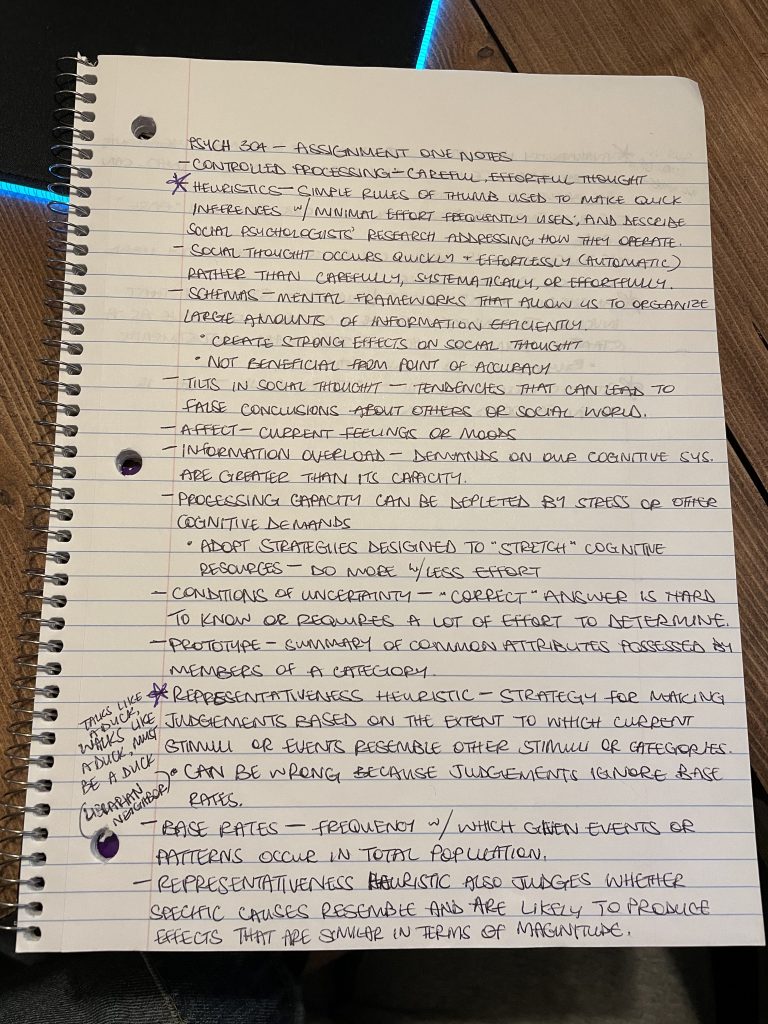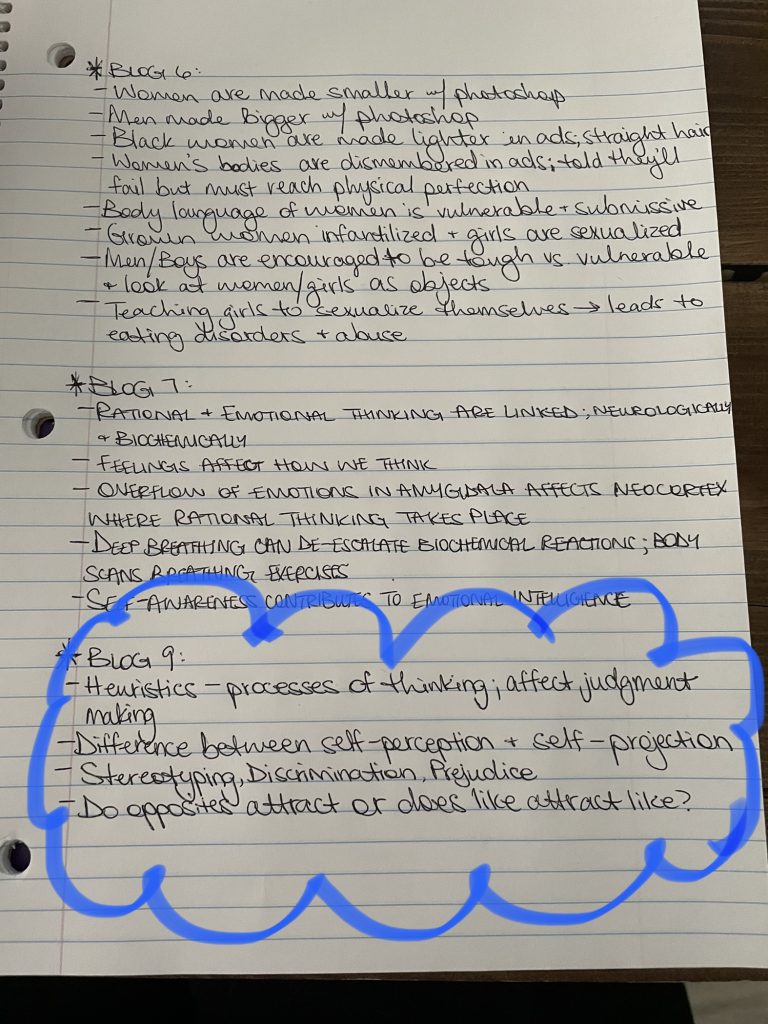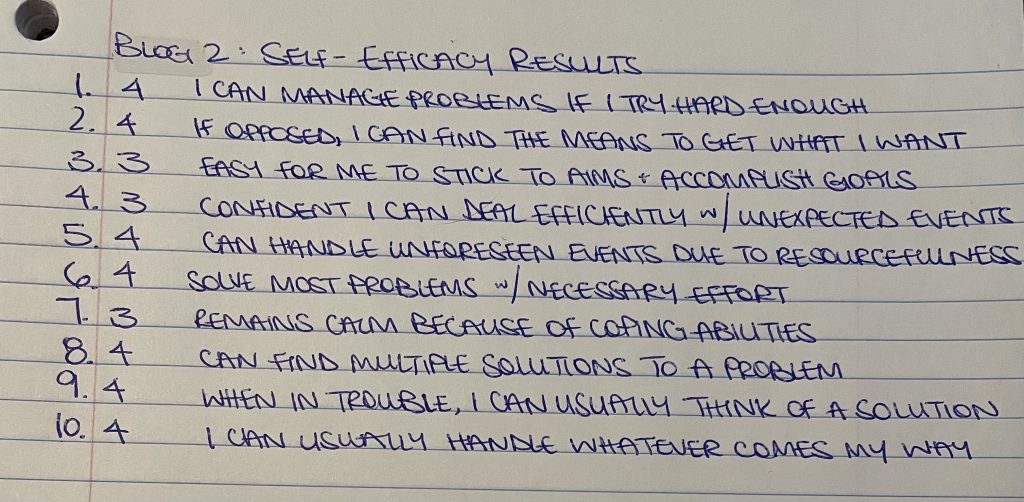Blog 10:
The course expectations I stated in my first blog post have been achieved throughout the course of this semester. I have successfully completed the course objectives outlined in the syllabus, acquired a deeper understanding of why individuals think the way they do, and gained a cohesive learning experience of Social Psychology that I can pair with my other Psychology courses. As stated in the course objectives, I have learned the processes used by social psychologists to determine how to test behaviors. I’ve learned methods such as correlation, observation, and meta-analysis that are used to test these hypotheses. I’ve also learned about heuristics which are mindsets that influence our decision making as well as the basis of our individual prejudices and how we use those to discriminate. Additionally, I’ve also gained knowledge on the components of what influences who and what we like in relationships.
I started this course believing that Social Psychology would teach me the mental processes behind social interactions. Although true, I learned more about other important aspects of Psychology. I learned that different psychological concentrations have different perspectives on hypotheses, approaches, and treatment methods. I also learned that correlation between factors and their outcomes does not mean direct causality. I know have a better understanding of Social Psychology’s integration into other areas of Psychology and its application to every day life.
If I were to take this class again I would like to take it in-person. This class covered topics that would cultivate diverse discussion that can only be experienced through face-to-face contact. Aside from that change, I am overall content with my experience in this course. Of course I wish I studied more but, other than that I am satisfied with the material I’ve learned, my success, and the overall structure of this course.
Throughout this course I have become a more diligent student. I have worked harder at studying, comprehending the material, completing assignments promptly, and staying motivated. I was a good student before I started this course, but I believe the structure of this class paired with the thoroughness of the professor made it possible for me to become a better student. Both of these factors enabled me to be confident in my plan of action and the work I produced. In addition to making me a more diligent student, Social Psychology made me become a more aware consumer. Whether it be a consumer of modern-day culture, current marketing and products, or information via the media, I have become more aware of what affects my thoughts and consequently, my decisions. This course gave me the skill of being a “conscious consumer” through learning about the different heuristics. Now I am able to identify which factors, like the representative heuristic, affect my thought processes and how those factors bring me to the conclusions I make.
I chose the above image because of its visual representation of academic growth. As shown, the brain being currently measured has grown from the stage it started at, seen to the right. Yet, the brain still has room to grow compared to the stage of the brain shown to the left. This image represents the transitions between before I took this course, during this course, and where I believe myself to be after this course, in regard to knowledge of Social Psychology.
Blog 9:
One of the most important topics I’ve learned in Social Psychology is the concept of heuristics. Heuristics are mental frameworks individuals use to form decisions, whether consciously or unconsciously (Branscombe et al., 2016). These mindsets influence what we think, how we think, and ultimately, our reactions or judgments to those thoughts. I deem this concept important because understanding what influences our thinking and judgments allows us to become less biased or “blinded” by media, marketing, and other social pressures. In assignment takeaway 1, I further explained how the availability heuristic, representative heuristic, and anchoring and adjustment heuristic all showcased the different biases created within these processes and how individuals’ decisions were influenced because of them. Acknowledging the influences on our thought processes as well as the impact the decisions made from those thoughts have, is crucial in making well-informed, accurate judgments.
Learning about this topic also helped me with other relating topics within this course. For example, learning about the representative heuristic helped me understand how people try to justify racial slurs through the usage of stereotypes in assignment takeaway 3. This course discussed how certain biases created with heuristics affected the marketing and products society would buy into.
Similarly, understanding the difference between self-projection and self-promotion is equally important. Self-promotion is when an individual wants certain self-aspects to be noticed so they emphasize certain attributes in an attempt to be more appealing (Branscombe et al., 2016). Self-promotion is used often in job interviews, college applications, and dating apps. These situations are experienced by all of society, which leads me to believe that learning about a concept that is experienced so often is vital in social development and understanding.
Discussed in “Item to Archive 3”, tactics like self-enhancement are utilized for better self-promotion. Altering one’s physical appearance through hygiene, clothing, makeup, and other appearance based changes are all self-enhancement techniques that can be used in various situations as self-promotion. Everyone wants to be seen as their best selves which leads to the frequent usage of such credential-boosting tactics.
Self-projection, however, is different in the sense that, although an individual wants to showcase their favorable traits, they are projecting what they would like to be or have versus what is their current reality. Learning about self-projection made me think of dissociative identity disorder, an abnormal psychological disorder I learned about in Abnormal Psychology. Through self-projection and dissociative identity disorder, individuals’ attempt to create a new reality with changing things about themselves. With self-projection, people will essentially manifest the version of themselves they wish to be, and with dissociative identity disorder people will also become a different version of who they are as a coping mechanism. Although different in purpose, both concepts show similarities.
This concept reminded me of reviewing how men and women are treated and portrayed differently in advertisements. Women and men alike are expected to self-promote so they can be viewed as more desirable. Men are supposed to self-promote by working out to gain larger muscles and perpetuate a toxic definition of masculinity. Meanwhile, women are expected to self-promote via cosmetic surgeries, makeup, and becoming known as a submissive servant to their dominating male counterpart.
Lastly, the debate between whether opposites attract or “like attracts like” is one of the most important topics covered in Social Psychology. This debate has a long-standing history outside of the virtual classroom. Again, I find this concept important because it is applicable to not only myself, but the rest of modern society. Throughout the “Item to Archive 3” exercise, I was able to witness two different couples with two different experiences regarding these theories. My mother and father follow the “opposites attract” theory. Incredibly different in personality, demeanor, and approach, my parents have been successfully and happily married for twenty five years. Much differently, my fiancé and I are incredibly similar in practically every regard. Of course we have to have some differences but, overall we believe the similarities we have in our beliefs, values, personality, and mindset helped cultivate our close bond and contributed to the success of our relationship. Learning about this concept made me think of Physiological Psychology in which the chemical reactions and biological reasoning for why people mentally work the way they do is explained.
All of the aforementioned topics are important to learn because of their applicability to everyday life and other psychological areas of study. Being able to recognize and understand social psychology topics leads to becoming a more informed consumer, student, and overall self-aware individual.
Blog 8:
After reading Nathan DeWall’s article on “Sexual Conflict: Uncovering the Mysteries of the Mating Battleground”, I was able to further acknowledge the differences between men and women in terms of the mating process. As stated in the article, men are more concerned with the amount of women they can have sex with, the attractiveness of who they have sex with, and “they have a lower minimum amount of obligatory parental investment” (Buss et al., 2017). The latter refers to the difference between how men and women feel toward short-term sex partners (Buss et al., 2017). Men also tend to look for younger mates which can be simplified to the primal need of reproduction. Whereas, women are concerned with the stability of resources, especially financial security, which causes them to focus on older men (Buss et al., 2017). Through reading this article I became more aware of the scientific evidence of the psychological differences of men and women in regard to mating.
Also discussed in the article was the different ways in which men and women upset each other. Most notably, men and women both upset each other with infidelity. Whether male or female, both genders can become upset when learning of their partner’s unfaithfulness. Men specifically can upset their female counterparts with lack of initiation romantically, lack of personal drive or ambition, being sexist or misogynistic, and being lazy. Unemployed men sitting on the couch not helping with household responsibilities while demanding their female partner make them dinner is a vivid representation of the aforementioned triggers that upset women. Similarly, women who are only concerned with men’s financial status, outer appearance, overall “what can you do for me” attitude can upset their prospective male partners. Men can become angry with women who exemplify “gold-diggers” or “wannabe housewives” who lack any ambition or drive to be successful on their own, only wanting to be taken care of by a man instead. Many situations or traits can be applied to both men and women that consequently make their partners angry and upset. As stated in the article, “successful heterosexual relationships accommodate these evolved sex differences” (Buss et al., 2017).
I chose these memes because they both represent what angers women and men respectively, about each other. Women are constantly “pigeon-holed” into being domestic, particularly at the discretion of men, with forced labels that are misogynist and disrespectful. This can be seen in the left picture of the woman becoming angry at the suggestion of a domestic activity like making a man a sandwich. The picture on the right showcases a woman only becoming interested in a man she initially deemed just a friend once he gains money. This “gold-digger” behavior angers men about women.
Blog 7:
There is a neurological and biochemical connection between self-regulation and emotional intelligence. Self-regulation is a person’s ability to deescalate their emotions so they can engage rational thinking. Naturally, feelings affect how we think. Specifically in stressful situations, our feelings of anxiousness or tension can cause us to react in a more defensive manner. As discussed in Dr. Linda Ferguson’s video, breathing exercises such as, body scans and traditional deep breathing, can relax the body completely before decision making occurs. Dr. Ferguson explains how an “emotional overflow” takes place within the amygdala which inhibits the rationality of the neocortex where judgment making takes place. By engaging in self-regulation, namely breathing exercises, we can better control our emotions and consequently, our reactions and decisions. The ability to self-regulate indicates a person is able to manage their emotions efficiently which contributes to overall emotional intelligence.
Aside from self-regulation, emotional intelligence for me, is also displayed in being able to decipher others’ emotions. The ability to interpret when someone is sad, disgusted, angry, happy, amused, etc. conveys a more complete emotional intelligence. When we’re aware of the vast array of emotions that exist and what those emotions can look like, we are more prepared to handle the reactions of the people feeling those emotions and the decisions they make because of them. Personally speaking, I display emotional intelligence through self-regulation, as discussed by Dr. Ferguson. Specifically, in situations that make me angry I will count to the number ten or breathe deeply while removing myself from the situation if possible, before engaging in any verbal remarks or judgment making. I can continue to improve my emotional intelligence by being more aware of the emotions displayed by those around me. Becoming more in tune with the emotions of those around me would enable me to be better equipped in handling the reactions of those people as well as being more helpful in potentially diffusing hostile or tense situations.
I chose this screenshot as my representative visual image because it explicitly shows my personal score. I scored 14/20 indicating that I have a slightly above average emotional intelligence. I was proud of my score because I find it important to be able to read the expressions of those around me and to be able to empathize with others.
Blog 6:
Prior to Jean Kilbourne’s Ted Talk, The Dangerous Ways Ads See Women, I was acutely aware of the points she discussed in regards to today’s marketing and advertisements. I previously took a Sociology class that discussed how women are the subjects of distortion, stereotyping, sexualization, objectification, and infantilization in today’s media. We were asked to dissect advertisements for the aforementioned components in which the class found a concerning number of media using these flawed tactics. Then and now, I find it incredibly repulsing that women are so blatantly and systematically disrespected through popular culture. It’s even more alarming to me that there are women who are brainwashed into contributing to this toxic narrative which only damages vulnerable women and impressionable girls. It is particularly disgusting that infantilizing women is seen as “desirable”. I can most certainly see a correlation with this and child pornography. As Ms. Kilbourne explained, the pornographic attitude used in marketing paired with the easy access to pornography, especially online, is destructive and toxic. These attitudes teach girls to sexualize themselves which can lead to longterm damage through eating disorders and abuse that follows them into adulthood.
This video also further elaborated on how women are so poorly treated in today’s marketing versus men. Women’s bodies are heavily distorted, dismembered, infantilized, objectified, put in submissive poses, and even made lighter if the woman’s skin is black. In heavy contrast, men’s bodies are made bigger, their poses are more dominant, and their behaviors are more aggressive. Ms. Kilbourne’s Ted Talk showed several examples of these tactics with several ads for mainstream products and companies. It made me question how major corporations can not only get away with these types of marketing, but how these ideas are even passed as “good” or “acceptable” to begin with! As with women, the encouragement for men to be aggressive, dominating, and objectifying of women creates a negative attitudes and toxic behaviors towards women. Men are taught to be these machines that make demands while women are taught to be dolls that take orders. Both mindsets are severely flawed and quite frankly, dangerous. By perpetuating these falsehoods, advertisements are hurting the consumers they are intended for.
https://elephanttoday.wordpress.com/2016/03/29/sexualizing-cologne-advertisements/ https://www.yesterdaysperfume.com/yesterdays_perfume/2014/01/vintage-perfume-commercial-loves-baby-soft-1975.html https://thesocietypages.org/socimages/2010/07/20/metaphorical-merri-go-round-likening-animals-to-women-and-women-to-animals/ https://www.dazeddigital.com/fashion/gallery/21016/1/american-apparel-advertisement-archive
Blog 5:

For my credible source, I chose a fear-based advertisement. As seen above, this ad focuses on the cessation of methamphetamine drug usage by using several individual teeth to spell out the word “meth”. The usage of rotten teeth is meant to warn current and potential users that they could lose their teeth, a vital part of everyday life. This fact is further augmented by the statement: “mefhanfhefamin festroys your frain. Fut fefore, you will lose all your feeth. Speaking without teeth is difficult. Think about it as long as you have a brain to do so”. This advertisement uses fear to educate as well as intimidate viewers about the harmful effects of meth usage. The fear tactic is useful here because society is trained to find dental hygiene important. Lack of dental hygiene scares many people because of the pain or long-term health effects is can cause. Therefore, using disgusting teeth to spell out a drug directly shows a cause and effect relationship between drugs and their consequences.

For my non-credibile source, I chose the above cigarette advertisement. This ad lacks credibility because the manufacturers of Viceroy cigarettes clearly have profit to gain from consumers purchasing their product. Viceroy claims that dentists recommend their particular brand of cigarettes which is a bold claim to make considering dentists have reached a collective consensus that cigarettes are detrimental to all aspects of oral health. This brand attempted to twist medical information along with using the presence of a “trusted” healthcare professional to persuade viewers that their brand of cigarettes is “healthy”. Despite their attempts, this Viceroy cigarettes campaign lacks credibility because it is evident the company has personal gain in suggesting this false information.

My attractive source showcases the popular star actor of Marvel’s Captain America, Chris Evans, seductively posed with an attractive female model. Personally, I do not find this advertisement effective. However, I do think it is effective for its intended male audience. Men typically like action movies, superheroes, being the object of female attention, and smelling good. Chris Evans is fawned over by women for his role as a powerful superhero as well as his physical looks. By using a well-known, highly sought-after attractive male, male viewers will connect seeing his presence in a cologne campaign with their own desire to smell good and be sought after by women. Additionally, the seductive posing along with the clearly shirtless models draws the male viewers attention to even look at the ad in the first place. This can also pull in female viewers who find Chris Evans attractive so that they also purchase the advertised cologne for men in their life.
Blog 4:
After reviewing my exam results to see which questions I answered incorrectly, I researched the correct answers. First, I looked through my notes to see if I had the information in my notebook. I take hand written notes for each module’s powerpoint. I find it is easier for me to retain the information if I write notes while reading the powerpoint. For supplemental information I also write notes as I read the article or watch the video provided. After reviewing the powerpoint and any supplemental information, I read the chapter via the online book link. I read the book chapter last because I like using it as an overall summary to fill in any gaps left from the powerpoint or supplemental information. As I read the book chapter I take handwritten notes of details or vocabulary I feel is necessary for me to know in general or in regard to exams.
Unfortunately for this course’s first exam, I did not complete the review sheet. I originally felt confident going into this exam because of the amount of notes I had taken, the time I dedicated to assignments and reading the chapters, and my overall understanding of each chapters’ concepts. I believe not completing the review sheet made a difference in my preparedness for the exam. Review sheets are typically understood to be a direct guide to what information is going to be emphasized on the exam. By not completing the review sheet, I prevented myself from helpful hints, in a sense. If I had completed the review sheet, I believe I could’ve taken my “good” grade and made it a “great” grade.
Moving forward I will continue to put all of my effort into the course as I have been, but I will certainly be completing any further review sheets. I will also participate in the Jeopardy review games provided via Blackboard. These review games are a useful way to quiz oneself on the course content aside from traditional studying. Additionally, I would look up the correct information on any incorrect answers and take notes accordingly.
Overall, I felt adequately prepared for the exam but, after taking the test I can see where I could’ve studied more. In addition to studying more, I also see what information I could’ve studied more and techniques I could’ve utilized for studying.
My representative visual image is of my handwritten notes and the powerpoint notes provided through Blackboard. This image illustrates two of the study mediums I use to prepare for this course’s exams. These notes aid me in comprehending the concepts outlined per chapter.
Blog 3:
Music preferences and relationships are clearly connected, as explained in the article, “Soul Meets Body”. Sharing musical selections with friends and/or romantic partners is an expressive way to relay what is important to a person or what demeanor a person may have. By sharing musical tastes, individuals can gage how much they may or may not have in common with others. Genres of music can be seen as characteristics of personality, therefore certain musical preferences can be indicative of how similar two people can be.
I have four close friends, including my fiancé. Of those four friends, there are two females and two males. We all have similar music tastes in different ways. My female friend, Meg, listens to pop, oldies, and light rock. My other female friend, Haley, listens to a lot of Christian music, electronic dance music, and pop. One of my male friends, Jesse, listens to pop punk exclusively. My fiancé, Cole, listens to rap, country, and rock. As the theory in “Soul Meets Body” suggests, my closest relationships are with the two people I have the most in common with, my fiancé, Cole, and my best friend, Meg. The three of us hold the same values, beliefs, and priorities. We are also in the same “chapter” of our lives, meaning we share in similar experiences. All three of us believe in God, prioritize our loved ones, plan on starting our own families, hold jobs, believe in being reliable friends, and overall decent human beings. Clearly, music preferences indicate deeper connections than just sounds people like to hear. As seen through my relationships, our collective music tastes indicate our similar values, beliefs, and overall personalities.
Musical selections can also remind a listener of a particular person or memory. Below are a list of songs that remind me of six key people in my life. All of the listed songs remind me of each individual person because of the relevance of the lyrics, genre, or a memory relevant to the song.
My Soundtrack:
My Ma: Dark Lady by Cher
My Dad: Cowgirls Don’t Cry by Brooks & Dunn
My Sister: I’m so tired… by Lauv & Troye Sivan
My Stepdaughter: Best of You by Andy Grammer
My Best Friend: Wannabe by The Spice Girls
My Fiancé: Bless the Broken Road by Rascal Flatts

I chose a photo of a broken road for my visual image because of the significance it has to my relationship with my fiancé. Despite the trials and tribulations we’ve faced individually and together, we’ve been able to find love within each other and end up happy.
Blog 2:
I would consider myself a “Type A” student. When applied in an academic context, I perceive this to mean that I am a diligent, deadline conscious, yet stressed, student. According to simplypsychology.org, Type A personalities experience more stress than their Type B and C personality counterparts, as well as focus more heavily on time and competitiveness (Mcleod, 2017). I am constantly making myself hyper-aware of when assignments are due. To keep myself organized, I use a planner in which I list all of my assignments, exams, and due dates. I color code each course by writing specific tasks with colored pens corresponding to each course’s designated color. Additionally, I match that colored ink to the color of the notebooks I use for each particular course. I am careful to review the assignments and information needed to be learned ahead of the due date so I can ensure that I complete all required work promptly. As due dates approach my stress levels increase if I do not have the assignments completed. With all of my courses I will stress out the entire assignment period until I have completed all the necessary work and have it officially turned in. Not only am I sensitive to time frames and stress, I am incredibly competitive. In an academic context, specifically the online learning atmosphere, I compete with myself. I always strive to do assignments and exams well, not at an average level. To me personally, average is failing. Fulfilling my potential, which I know is higher than average, is succeeding. Since I hold this mindset dearly, I am competitive with myself to achieve the highest grades I can possibly attain.
Currently at this point in the semester, I am confident in my academic performance and ability to be successful. However, my confidence has been slightly lowered after I underwent surgery during the first week of classes. Attempting to recover from my procedure while keeping up with multiple courses has been difficult, and at one point, put me behind schedule. As I stated in the beginning of this blog post, I am a diligent student. Due to this diligence and better time management skills, I have been able to get back on track. In doing so, I have gained my confidence back in my abilities as a student, and my overall success for this semester. Implementing better time management skills enabled me to complete my assignments and other academic tasks in a more prompt manner. I could then put the remainder of the time frame given for the assignment towards a relaxed study of the material.
My self-efficacy results echoed this sentiment. With a mean score of 3.7, or 37 out of 40, I displayed high levels of self-confidence in my ability to perform my academic tasks. As expected, I believe in myself to complete my schoolwork efficiently. Extending outside of schoolwork, my self-efficacy score indicates my belief in my ability to handle stress and unforeseen events, manage and resolve problems, and remain calm while doing so. As support to this score, all of my grades thus far have been exceptional. These above average grades have been possible due to my self-confidence in my academic ability, adaptability to changes in schedule, and level of calmness during such changes.
Reference: Mcleod, S. (Ed.). (2017). Type A and Type B Personality Theory: Simply Psychology. Type A and Type B Personality Theory | Simply Psychology. https://www.simplypsychology.org/personality-a.html.
As shown above, I uploaded a screenshot of my self-efficacy results. This picture directly shows my scores accompanied by a short-hand description of each question. Choosing this photo encompassed the essence of this blog post, as it clearly shows my high level of self-confidence. As discussed in the above text, my score of 37 out of 40 illustrates my solid belief in my academic abilities and consequential success.
Blog 1:
The combination of objectives outlined within this course create an overall better understanding of Social Psychology. As stated in the course syllabus, students will be able to understand the scientific methods used by social psychologists that help determine hypotheses about individual and group behaviors. This objective is beneficial in regard to future research purposes as well as a personal standpoint because it will enable me to understand the process of research as a whole and be able to apply it to my everyday life. Through learning these fundamental first steps of research, I expect to be able to conduct future research of my own properly and accurately. As well as understand my own behavior on a deeper level.
Another course objective listed, in which factors influencing relationships are examined, further develops the ability to understand individual and group social behavior. Discussing the reasons why people like what they like and how that leads them to who they form relationships with is an aspect of Psychology seen in everyday life. There is a direct correlation between what individuals like and who they end up with based on those likes. I expect to further understand why individuals have the particular likes and dislikes they have, especially when compared to others in their social groups. This directly relates to another objective in which students will look at how people perceive and understand others. An individual’s impressions of another person mold how they will treat such person. I expect to understand the “why” behind the perceptions we get from individuals and how that affects our treatment of those individuals. This understanding is especially useful in the workforce when many diversified backgrounds and ideas are melded together. Being able to understand how formed attitudes from perceptions of others affect our behavior contribute to our judgments and decision making. How we treat and interact with others is directly affected by the perceptions we have of such people. These ideas form our prejudices and discriminatory tendencies. I want to learn how individuals take their attitudes, prejudices, and perspectives on others and use them to form their decision making. I want to further understand how all of these components are interwoven in social behavior and judgements.
In accomplishing all of these course objectives, I hope to gain a multifaceted understanding of how Psychology affects and influences behavior of individuals and groups. Melding a combination of Psychology courses together will allow for a more cohesive understanding of Psychology as a whole. My goal in this course specifically is to learn as much as possible about Social Psychology and apply that to other Psychology courses as well as a future Psychology career.
To ensure I am able to achieve my goal, I must implement strategies for success. Time management and thorough comprehension of topics presented is crucial to do well in this course. In terms of time management, I will need to continue to plan out assignments, allow enough time to complete assignments properly, and give myself enough time to comprehend all of the information learned. In terms of comprehension of information, I need to continue to the corresponding book chapters per module, complete assignments relating to the necessary material, and thoroughly study the notes, assignments, and readings outlined per module. By implementing these strategies for success I believe I can gain all of my desired expectations.

As seen, I have uploaded a picture of my handwritten notes for Assignment One. I chose this particular photo because it clearly illustrates my dedication to comprehending the information we are provided per module. Courses are not just about doing well, they are also about learning. The knowledge Social Psychology will imprint on me will undoubtedly be referenced and utilized in my personal life and academic career.











